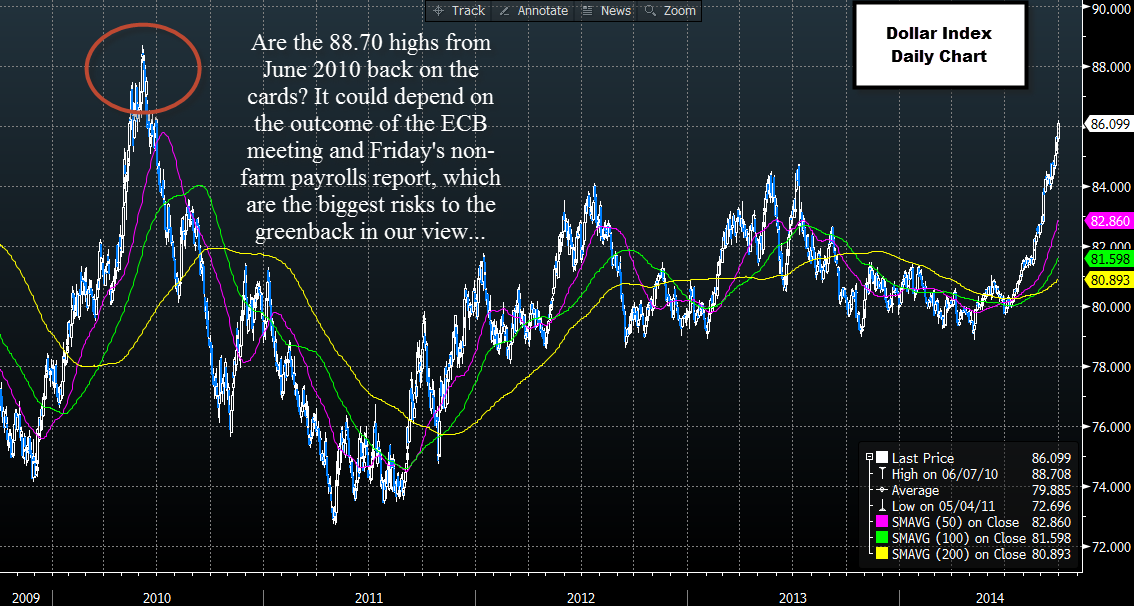![]()
The dollar is back. After taking a breather on Monday, it is continuing to push northwards as we move into the last day of the month. September has been a stellar month for the greenback; the dollar index has risen by 3%, its best monthly performance for 2 years. What is more amazing is that the USD has risen even though the August payrolls report was much weaker than expected, and even though some Fed members, including the powerful William Dudley from New York, have been throwing about suggestions that rates won’t rise until inflation is above 2% (currently it is at 1.7%).
The market seems to be ignoring the fact that the Fed has stuck with its pledge to keep interest rates low for a “considerable” period of time, and is instead focusing on life after QE3, which ends next month. This surely heralds the start of the Fed’s normalisation programme? Even if the Fed doesn’t embark on actual rate hikes any time soon, the fact that it is no longer expanding its balance sheet is good enough for this market.
The interesting thing for the dollar will be Friday’s payrolls report. If payrolls are sub 150k for another month will investors start to question the strength of the US economic recovery? In our view things would have to get very bad before investors were willing to buy the euro back against the dollar. Thus, the market could be willing to forgive another indiscretion from the payrolls report, although we don’t think that payrolls will be forgotten about entirely, especially if inflation data remains weak.
One of the reasons for today’s surge higher in the buck is the weakness of the EUR, which fell off a cliff after September CPI data showed core prices for the currency bloc falling back to 0.7%, and headline price growth dipping to its lowest level since 2009 at 0.3%. Since the ECB’s only mandate is to maintain stable prices, this data is further evidence that they are failing miserably. The drop in EURUSD to an intra-day low of 1,2570 is partly due to the market pricing in the prospect of further action at the ECB meeting later this week.
Key risks for the buck
There are two risks for the dollar this week: 1, NFPs disappoint again, throwing into doubt some of the market’s expected Fed hawkishness, and 2, the ECB fails to announce any new policy measures, which fuels a mini-rebound in the single currency. For now, the fundamentals and the technical picture is in favour of a stronger USD, however, things could change in the next 3 days so make sure you are watching your economic calendar and Draghi’s comments closely.
The technical view:
The dollar index continues to extend recent gains and the broader bullish pattern of higher highs and higher lows suggests that momentum is on the upside, and we could continue to push higher. The next level of resistance that we are focusing on is 86.98 – the 138.2% Fib extension of the July 2013 – May 2014 bear trade. As we wait for the key ECB meeting and NFP data, set-backs could be limited, with today’s low at 85.49 acting as interim support. If we get an external shock, like a less dovish ECB or a weak payrolls number, then we could see a sharper loss in the greenback, with the next level of key support at 85.05.
Takeaway:
The dollar is rounding off a stellar performance in September in style.
This is the best monthly performance by the dollar for 2 years.
The dollar has managed to ignore a weak August payrolls figure and some concern amongst Fed members about weak inflation.
Although we would not want to argue with the strong dollar trend, the ECB meeting and the NFP report, both due later this week, are the biggest risks to the dollar’s uptrend, in the short term.
Key resistance is 86.97, while any knock to the dollar could push the buck down to support at 85.05.

CFD’s, Options and Forex are leveraged products which can result in losses that exceed your initial deposit. These products may not be suitable for all investors and you should seek independent advice if necessary.
Recommended Content
Editors’ Picks
EUR/USD retreats below 1.0700 after US GDP data

EUR/USD came under modest bearish pressure and retreated below 1.0700. Although the US data showed that the economy grew at a softer pace than expected in Q1, strong inflation-related details provided a boost to the USD.
GBP/USD declines below 1.2500 as USD rebounds

GBP/USD declined below 1.2500 and erased the majority of its daily gains with the immediate reaction to the US GDP report. The US economy expanded at a softer pace than expected in Q1 but the price deflator jumped to 3.4% from 1.8%.
Gold drops below $2,320 as US yields shoot higher

Gold lost its traction and turned negative on the day below $2,320 in the American session on Thursday. The benchmark 10-year US Treasury bond yield is up more than 1% on the day above 4.7% after US GDP report, weighing on XAU/USD.
XRP extends its decline, crypto experts comment on Ripple stablecoin and benefits for XRP Ledger

Ripple extends decline to $0.52 on Thursday, wipes out weekly gains. Crypto expert asks Ripple CTO how the stablecoin will benefit the XRP Ledger and native token XRP.
After the US close, it’s the Tokyo CPI

After the US close, it’s the Tokyo CPI, a reliable indicator of the national number and then the BoJ policy announcement. Tokyo CPI ex food and energy in Japan was a rise to 2.90% in March from 2.50%.